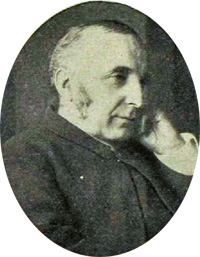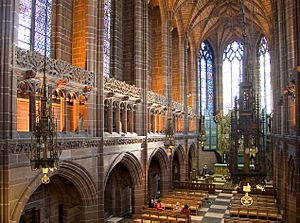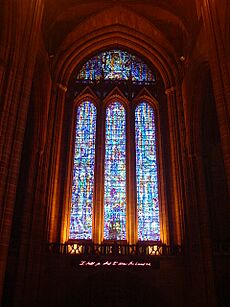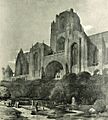Liverpool Cathedral facts for kids
Quick facts for kids Liverpool Cathedral |
|
|---|---|
| Cathedral Church of Christ in Liverpool | |
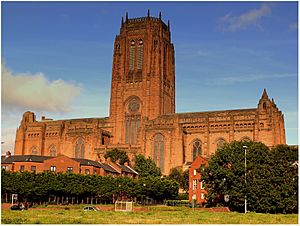
Liverpool Anglican Cathedral, St James's Mount
|
|
| 53°23′51″N 2°58′23″W / 53.39750°N 2.97306°W | |
| Location | Liverpool |
| Country | England |
| Denomination | Church of England |
| Tradition | Central churchmanship |
| History | |
| Dedication | Christ |
| Architecture | |
| Architect(s) | Sir Giles Gilbert Scott |
| Style | Gothic Revival |
| Years built | 1904–1978 |
| Specifications | |
| Length | 188.67 m (619.0 ft) |
| Nave height | 35.3 m (116 ft) |
| Choir height | 35.3 m (116 ft) |
| Number of towers | 1 |
| Tower height | 100.8 m (331 ft)1 |
| Bells | 14 |
| Tenor bell weight | 82-0-11 (4171kg) in A♭ |
| Administration | |
| Diocese | Liverpool (since 1880) |
| Province | York |
Liverpool Cathedral is a huge and beautiful Church of England cathedral in Liverpool, England. It is the main church for the Liverpool area. Its full name is the Cathedral Church of Christ in Liverpool.
This cathedral is the largest religious building in Britain. It is also the seventh largest church in the world! It was designed by Giles Gilbert Scott and took a long time to build, from 1904 to 1978. It is the longest cathedral in the world. Its total length, including the Lady Chapel, is about 207 yards (189 meters). The cathedral is also very tall, reaching 331 feet (101 meters). This makes it one of the tallest non-spired churches globally. It is also the fourth-tallest building in Liverpool. The building is considered a Grade I listed building, which means it's very important historically.
Liverpool has two cathedrals. The other one is the Roman Catholic Metropolitan Cathedral of Christ the King. It is about half a mile away. The two cathedrals are connected by Hope Street.
Building the Cathedral
Why a New Cathedral Was Needed
In 1880, J. C. Ryle became the first Bishop of Liverpool. At that time, Liverpool did not have a proper cathedral. They used a smaller church called St Peter's. This church was too small for big events and was not very pretty.
So, in 1885, a law was passed to allow a new cathedral to be built. An early design was chosen, but the site was not suitable. In 1900, Francis Chavasse became the new Bishop. He really wanted to build a great church. He believed it would be "a visible witness to God in the midst of a great city."
After looking at different places, a committee chose St James's Mount. This spot was perfect because it could be seen from far away and from the city. Another law was passed in 1902 to buy the land and start building. The old St Peter's Church was eventually closed and taken down to help pay for the new cathedral.
Choosing the Design
In 1901, a competition was held to find the best design for the new cathedral. Architects were asked to create designs in the Gothic Revival style. This style was popular for churches at the time. Many architects entered the competition. This was a big deal because it was only the third time an Anglican cathedral was built in England since the 1500s.
In 1903, a surprising winner was chosen: 22-year-old Giles Gilbert Scott. He was still a student and had not designed any major buildings before. Even though he was young and a Roman Catholic, the committee decided to stick with his design.
Scott's Early Plans
Scott was very talented, coming from a family of famous church designers. Because he was so young, the committee asked an experienced architect, George Frederick Bodley, to help him. Work started quickly, and King Edward VII laid the first stone in 1904.
However, Scott and Bodley did not always agree. Bodley was often away working on other projects. Scott felt frustrated. When Bodley suddenly passed away in 1907, Scott became the only architect in charge.
Scott's New Design (1910)
By 1909, Scott felt more confident. He decided to change his original design for the main part of the cathedral. His first plan had two towers at the front. His new plan featured one large central tower, which would be 85 meters (280 feet) tall. This new design also created more space inside. The committee approved his new plans in 1910. Scott also made the decorative style more modern, moving away from some of the older Gothic details.
The Lady Chapel
The Lady Chapel was the first part of the cathedral to be finished. It was officially opened in 1910. This chapel is dedicated to the Blessed Virgin Mary. It has beautiful stained glass windows. These windows show women who made important contributions to society.
Some of the notable women in the windows include:
- Julian of Norwich, a theologian.
- Susanna Wesley, mother of Methodism.
- Elizabeth Fry, a social reformer.
- Josephine Butler, a feminist and social reformer.
- Queen Victoria, a famous queen.
- Grace Darling, a brave lighthouse keeper's daughter.
- Kitty Wilkinson, who opened the first public washhouse in Liverpool.
- Anna Hinderer, a missionary.
Building Continues
Work slowed down during the First World War (1914-1918) because of a lack of workers and materials. By 1920, building picked up again. The pinkish-red sandstone used for the cathedral came from local quarries in Woolton.
The first main section of the cathedral was finished by 1924. This included the chancel (the area around the altar). On July 19, 1924, the cathedral was officially opened in the presence of King George V and Queen Mary.
Work continued steadily after that. The Second World War (1939-1945) again caused delays. The building was even damaged by German bombs during the May Blitz in Liverpool. Despite this, the central section was mostly finished by 1941. Scott himself laid the last stone of the tower's top in 1942. Work on the main part of the church, called the nave, began in 1948.
Finishing the Cathedral
Scott passed away in 1960. His assistant, Frederick Thomas, took over as architect. Thomas designed a new west front for the cathedral. The building was finally completed in October 1978. Queen Elizabeth II attended a special service to mark its completion. It was a big moment for Liverpool.
Inside the Cathedral
The cathedral is truly massive. It is 188.7 meters (619 feet) long and covers an area of 9,687.4 square meters (104,274 square feet). The tower is 100.8 meters (331 feet) high. The main vaults inside are very tall, reaching over 35 meters (115 feet).
The cathedral was built mostly from local pink sandstone. Each stone block inside is slightly different. This is said to symbolize God's love for each unique person.
The belltower is one of the largest and tallest in the world. It holds the highest and heaviest set of ringing bells in the world. These bells are called the Bartlett Bells. There is also a huge bell called "Great George." It weighs 14.5 tons and is the second largest working bell in the British Isles.
Services and Activities
The cathedral is open every day from 8:00 AM to 6:00 PM. Regular church services are held daily. On Sundays, there is a main service at 10:30 AM. The cathedral choir often sings at these services.
Admission to the cathedral is free, but visitors are encouraged to make a small donation. The cathedral also hosts many other events. These include concerts, school events, graduations, and exhibitions. It can hold up to 3,500 people standing for big events.
The cathedral even has its own special police force, called the Liverpool Cathedral Constables. They help keep the building safe 24 hours a day.
Music at the Cathedral
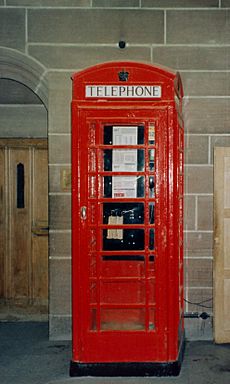
The cathedral has the largest pipe organ in the UK. It is also one of the biggest musical instruments in the world! It has over 10,000 pipes. There are two control panels for the organ. One is high up in the organ case, and the other is a mobile one on the floor. An annual concert is held to celebrate the organ's opening.
Many talented musicians have served as organists and directors of music at the cathedral over the years.
Art and Sculptures
The cathedral is home to many beautiful artworks. From 1931, Edward Carter Preston created over fifty sculptures for the building.
In 1993, a large bronze sculpture called "The Welcoming Christ" by Dame Elisabeth Frink was placed above the west door. It was one of her last works.
In 2008, a pink neon sign by artist Tracey Emin was installed. It reads "I felt you and I knew you loved me." It was meant to be temporary but became a permanent feature. Another of her works, a small bronze sparrow on a pole, is outside the Oratory Chapel.
A 15-foot tall wooden sculpture called The Outraged Christ by Charles Lutyens is also on display.
In 2024, the cathedral hosted an exhibition by famous sculptor Anish Kapoor. He said his works in the cathedral aimed to make people think about religious experiences.
Stained Glass Windows
Most of the stunning stained glass windows were designed by the firm of James Powell and Sons. The Te Deum window at the east end is particularly famous. The Lady Chapel windows were damaged during the war but were later replaced with similar designs. The cathedral has about 1,700 square meters (18,300 square feet) of stained glass.
Burials
Several important people are buried at the cathedral. These include Bishop Chavasse and the architect Sir Giles Gilbert Scott. Other bishops and important donors are also buried there. The ashes of Thomas Bartlett, who funded the bells, are in the ringing room.
Images for kids
-
Giles Gilbert Scott's winning design, with twin towers
See also
 In Spanish: Catedral de Liverpool para niños
In Spanish: Catedral de Liverpool para niños




